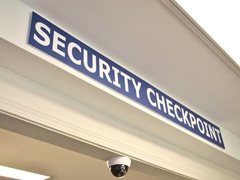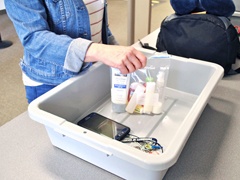 Today’s passenger and cabin baggage screening process is functional and airports manage to get by, but it is not sustainable in the long run given the industry’s predicted growth. The current screening model is inefficient and comes at the cost of many within the industry including airlines and passengers. For the past few years, several airports have shifted their attention to Smart Security solutions to handle the screening of passengers and their belongings.
Today’s passenger and cabin baggage screening process is functional and airports manage to get by, but it is not sustainable in the long run given the industry’s predicted growth. The current screening model is inefficient and comes at the cost of many within the industry including airlines and passengers. For the past few years, several airports have shifted their attention to Smart Security solutions to handle the screening of passengers and their belongings.
Smart Security is a joint initiative of the International Air Transport Association (IATA) and Airports Council International (ACI). Its goal is to streamline the passenger journey from curb to airside. The idea of Smart Security has been around for a few years now and the industry is just now able to implement these ideas into practical solutions without sacrificing safety and security.
What is Smart Security?
Smart Security is an environment where passengers experience the least amount of inconvenience when it comes to airport screening. Typically, this means employing risk-based solutions with advanced screening technologies, optimized airport configurations, and innovative processes to ensure a seamless progression from landside to airside. If you are familiar with Checkpoint of the Future, Smart Security is the next generation employing the first round of tests in various airports worldwide.
Benefits of Smart Security
 More effective screening. Better detection technology means there will be less divestment requirements and human resources are better allocated to other areas of need. Discovery of threats and prohibited items will occur more often.
More effective screening. Better detection technology means there will be less divestment requirements and human resources are better allocated to other areas of need. Discovery of threats and prohibited items will occur more often.- Improved operational efficiency. A streamlined screening process results in improved passenger throughput and reduced landside queues leading to further revenue for establishments on airside. In addition, airlines may be able to offer reduced layover times or more connecting flights.
- Better passenger experience. The screening process will be quicker, the tactics will be less intrusive, and delays will occur less often resulting in more passengers who are pleased with both airports and airlines.
Keys to Success
 There must be a willingness to embrace new technology. Better detection technology focused on automation means less dependence on personnel and their individual abilities – saving a great deal of time. It also means less intrusive screening for passengers and reduced divestment of items such as LAGs and laptops. Airports must realize the importance of investing in new technology and be willing to integrate them in a meaningful way. At the same time, they must consider how to best repurpose existing detection equipment.
There must be a willingness to embrace new technology. Better detection technology focused on automation means less dependence on personnel and their individual abilities – saving a great deal of time. It also means less intrusive screening for passengers and reduced divestment of items such as LAGs and laptops. Airports must realize the importance of investing in new technology and be willing to integrate them in a meaningful way. At the same time, they must consider how to best repurpose existing detection equipment.
There must be process innovation. Airports need to identify new and improved methods for carrying out screening as efficiently as possible. This means implementing new procedures for risk-based screening and re-evaluating the decision-making process of personnel. Security personnel should be placed in areas where their skills are needed most. In addition, airport configurations must be optimized by rearranging both equipment and personnel to ensure sensible and effective flow through the security checkpoint.
